Goldenrod, Harbinger of Fall
go.ncsu.edu/readext?625773
en Español / em Português
El inglés es el idioma de control de esta página. En la medida en que haya algún conflicto entre la traducción al inglés y la traducción, el inglés prevalece.
Al hacer clic en el enlace de traducción se activa un servicio de traducción gratuito para convertir la página al español. Al igual que con cualquier traducción por Internet, la conversión no es sensible al contexto y puede que no traduzca el texto en su significado original. NC State Extension no garantiza la exactitud del texto traducido. Por favor, tenga en cuenta que algunas aplicaciones y/o servicios pueden no funcionar como se espera cuando se traducen.
Português
Inglês é o idioma de controle desta página. Na medida que haja algum conflito entre o texto original em Inglês e a tradução, o Inglês prevalece.
Ao clicar no link de tradução, um serviço gratuito de tradução será ativado para converter a página para o Português. Como em qualquer tradução pela internet, a conversão não é sensivel ao contexto e pode não ocorrer a tradução para o significado orginal. O serviço de Extensão da Carolina do Norte (NC State Extension) não garante a exatidão do texto traduzido. Por favor, observe que algumas funções ou serviços podem não funcionar como esperado após a tradução.
English
English is the controlling language of this page. To the extent there is any conflict between the English text and the translation, English controls.
Clicking on the translation link activates a free translation service to convert the page to Spanish. As with any Internet translation, the conversion is not context-sensitive and may not translate the text to its original meaning. NC State Extension does not guarantee the accuracy of the translated text. Please note that some applications and/or services may not function as expected when translated.
Collapse ▲The bright yellow plumes of the Goldenrod that wave gracefully along roadsides & in waste areas from July to November have drawn the attention of American gardeners for the past several years. Because of its ability to survive roadside conditions, Goldenrod is an ideal candidate for low water use areas in the home landscape. Unlike many tall flowers, goldenrod grows sturdy and upright, thus requiring no stakes. Plant forms tend to improve under cultivation, but some goldenrod can become aggressive and weedy (almost invasive) in rich soil. Flower heads make long-lasting cut flowers. Dried sprays are particularly useful in herbal wreaths and fall wall ornaments.
This showy plant should be a prime candidate for late-season color in perennial plantings. Goldenrod is so conspicuous in the landscape it usually gets the blame for fall hay fever. Actually, ragweed is the major culprit of nasal distress. Ragweed blooms at the same time as goldenrod, but it’s small, dull, yellow-green flowers do not attract the eye of humans, nor many insect pollinators. For fertilization, the ragweed plant produces large quantities of light pollen that are carried by the wind to other plants. By comparison, goldenrod pollen is too heavy to be airborne long, & bees are the principal pollinators.
Most garden catalogs feature a few varieties of goldenrod for sale. Local nurseries also usually carry a selection of goldenrod. Check out local plant sales coming up in October. Wing Haven, UNCC Botanical Garden, Daniel Stowe Botanical Garden and the Extension Master Gardener℠ volunteers of Union County plant sale all take place in October.
Join the Extension Master Gardener volunteers of Union County for a Ask a Master Gardener on Saturday, September 28, 9–11 a.m., at the Teaching Garden located at the Union County Ag Center.





